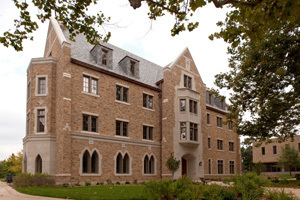
The University of Notre Dame’s Geddes Hall is coming to life.
The staff of the University’s Center for Social Concerns (CSC) moved into the newly constructed building this summer, and will be joined by other units of the Institute for Church Life (ICL)—the Center for Catechetical Initiatives, the Church Music Initiative, Notre Dame Center for Liturgy, Notre Dame Vision and the Satellite Theological Education Program—and others dedicated to educating the mind and the heart.
University leaders believe the 64,000-square-foot structure sends powerful messages to the Notre Dame family, connecting the organizations inside more broadly with the University and its mission.
After four decades of existence, it’s the first time the activities of the ICL will be under one roof. These entities are also coming together in the first Notre Dame building that can be called “green”—designed to meet national certification standards combining environmental sustainability and energy efficiency.
How does a new building, constructed in less than a year-and-a-half, get so connective, and so expressive, so fast? Its first compelling message is written right over the main doorway: “God is Love.”
ICL Director John Cavadini and Rev. Bill Lies, C.S.C., executive director of the Center for Social Concerns, agree that that’s a good start.
“This vision of integration was implicit from the building’s beginning,” said Cavadini, who also is associate professor and chairman of Notre Dame’s Department of Theology.
Echoing the theme of Pope Benedict XVI’s encyclical by the same name, those three words declare that the ICL’s nationally respected work in theological, liturgical and institutional formation fits well with the work of the CSC. The latter is an engine for engaging 80 percent of the Notre Dame student body in some form of local or global service learning annually, on behalf of peace, justice and human dignity.
The integrated wisdom summed up as “God is Love” will offer new inspirations regularly to those entering or exiting the building, Cavadini said. He points to the wholeness of Catholic social tradition and the Catholic Catechism’s combination of creed, sacramental life and ethics.
“If you think of ‘Church Life’ as a kind of flow from belief to worship to service, Geddes Hall symbolizes that flow,” he said.
Most of the first floor of the building is used by the CSC, with additional inviting spaces for student and faculty conversation, plus rooms named after heroes such as Rosa Parks and Dorothy Day. ICL facilities, alongside offices for the academic minor in poverty studies and minor in Catholic social tradition, occupy much of the upper floors, and the basement features a 125-seat auditorium.
Visitors enter the main doorway to observe a chapel dedicated to Our Lady of Mercy on the left and the CSC’s trademark “coffee house”/community-gathering space on the right. The gathering spaces, Father Lies said, will enhance the CSC as “an important link for this campus to the local community,” and he also looks forward to collaborations with other Geddes-based colleagues.
The opportunities for cooperation being established, along with the inherent “green” and “sustainable” characteristics that reaffirm Catholic social tradition, make the building itself “a teaching tool,” he said.
University President Emeritus Rev. Theodore M. Hesburgh, C.S.C., who played key roles in getting Geddes off the ground as well as in launching the predecessor organizations for the major entities now headquartered there, takes great joy in what the new building will be demonstrating to Notre Dame, through Notre Dame, and about Notre Dame. His office in the Hesburgh Library has a westward view of the campus’s spiritual and administrative heartlands, with Geddes Hall in closest proximity.
Such a stand-alone structure is unique among Catholic college campuses, he said, to embody this commitment of centralized—and urgently needed—space for the University’s service to the Church and to the whole of God’s creation.
“I’ve watched that building grow up, and now I can look out and the building is complete,” Father Hesburgh said. “I really rejoice every time I see it.”